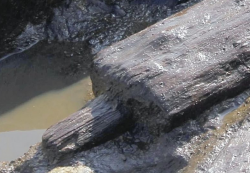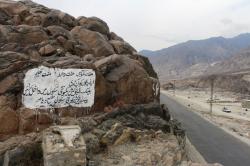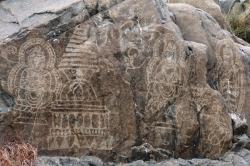INSTITUT SUPERIEUR D'ANTHROPOLOGIE
INSTITUTE OF ANTHROPOLOGY
ONLINE COURSES / COURS A DISTANCE
SPRING TERM : APRIL 2015
REGISTER NOW
JAPON –  Noto - A rectangular timber with its tip shaped into a tenon, presumably from the Jomon period, has been discovered among ancient ruins in Noto, Ishikawa Prefecture, according to the town’s board of education. The timber, discovered at the town’s Mawaki remains from the Jomon period (ca 10,000 B.C. to 300 B.C.), is believed to be the oldest of its kind ever found in Japan, according to the education board. Until today, the mortise-tenon joint technique is believed to have started in the Yayoi period (ca 300 B.C. to A.D. 300), as no timbers with a tenon were discovered from any timber remains before the Yayoi period. The mortise-tenon technique is a method used to join two pieces of timber. According to the announcement, the discovered timber, about 1 meter long, had a 10-centimeter-long tenon that is 6 centimeters thick. The timber is 16 centimeters wide at its widest area and about 7 centimeters thick. The tenon and the joint part were elaborately whittled so the timber could be connected vertically. The shape of the tenon was close to that of a contemporary tenon, according to observers. No timber pieces with a corresponding mortise have been found. “It is an important historical discovery in terms of studying woodwork from the Jomon period,” said Tokyo Metropolitan University Prof. Masahisa Yamada, an expert on archaeology who participated in the excavation. “It is possible the timber was made as part of a column for a special facility for a ritual of some sort, not for a house.” According to Yamada, timbers were excavated from the Jomon-period Miyanomae remains in Hida, Gifu Prefecture, but they were not processed to make a mortise-tenon joint. Primitive tenons had been discovered in two ruins of the Jomon period — the Oshorodoba remains in Otaru, Hokkaido, and the Shimoyakebe remains in Higashi-Murayama, Tokyo. However, they were logs, and their tenons had been made simply by shaving the edge of the log. Primitive tenons had been discovered in two ruins of the Jomon period — the Oshorodoba remains in Ota.
Noto - A rectangular timber with its tip shaped into a tenon, presumably from the Jomon period, has been discovered among ancient ruins in Noto, Ishikawa Prefecture, according to the town’s board of education. The timber, discovered at the town’s Mawaki remains from the Jomon period (ca 10,000 B.C. to 300 B.C.), is believed to be the oldest of its kind ever found in Japan, according to the education board. Until today, the mortise-tenon joint technique is believed to have started in the Yayoi period (ca 300 B.C. to A.D. 300), as no timbers with a tenon were discovered from any timber remains before the Yayoi period. The mortise-tenon technique is a method used to join two pieces of timber. According to the announcement, the discovered timber, about 1 meter long, had a 10-centimeter-long tenon that is 6 centimeters thick. The timber is 16 centimeters wide at its widest area and about 7 centimeters thick. The tenon and the joint part were elaborately whittled so the timber could be connected vertically. The shape of the tenon was close to that of a contemporary tenon, according to observers. No timber pieces with a corresponding mortise have been found. “It is an important historical discovery in terms of studying woodwork from the Jomon period,” said Tokyo Metropolitan University Prof. Masahisa Yamada, an expert on archaeology who participated in the excavation. “It is possible the timber was made as part of a column for a special facility for a ritual of some sort, not for a house.” According to Yamada, timbers were excavated from the Jomon-period Miyanomae remains in Hida, Gifu Prefecture, but they were not processed to make a mortise-tenon joint. Primitive tenons had been discovered in two ruins of the Jomon period — the Oshorodoba remains in Otaru, Hokkaido, and the Shimoyakebe remains in Higashi-Murayama, Tokyo. However, they were logs, and their tenons had been made simply by shaving the edge of the log. Primitive tenons had been discovered in two ruins of the Jomon period — the Oshorodoba remains in Ota.
http://the-japan-news.com/news/article/0001883653? http://the-japan-news.com/news/article/0001883653?
INDE - Moghalmari- Archaeologists who are excavating a Buddhist vihara out of the mounds at Moghalmari near Dantan in West Midnapur, are likely to fix the dates of the vihara between 5th and 7th century AD. On Wednesday, the state archaeology department restarted excavation at the site. The excavation is expected to be complete within the year and archaeologists would be able to lay their hands on the precious seal that holds the secret to the date of the origins of the vihara and its name, going by Buddhist traditions. All along the history of Bengal suggests that Raktamrittika vihara of the erstwhile Karna Subarna or Murshidabad is the oldest in Bengal dating back to the 6th and 7th centuries AD. Archaeologists have been working at the site for the past 12 years. In 2003, faculty and students of the archaeology department of Calcutta University started excavating the site after they were shown the mound by locals who also had an accompanying lore to share. Gradually a boundary wall, potsherds, figures and finally cells in which monks lived were unearthed, convincing archaeologists that they were indeed excavating a vihara. In 2009, the entrance gate came up during excavation. Last year, archaeologists found gold coins, pendants with inscriptions and several tablets that virtually ascribed a date to the vihara. "We are quite sure from the inscriptions that the vihara was fully operational during the time of King Samachar Dev, who ruled in Bengal during the time of Kumara Gupta. There are some Burmese inscriptions and also some in Pali to the effect Yeh Dharma Hetu....Saman. These are being tested now," said state archaeology department official and director of Moghalmari excavation project Prakash Maiti.
http://timesofindia.indiatimes.com/City/Kolkata/Excavation-restarts-at-monastery/articleshow/46047421.cms
CHINE - Renshui – Six ancient tombs built during theYuan Dynasty (A.D. 1271-1368 ) have been unearthe in north;China's Hebei Province, providing new artifacts for cultural research. The tombs, discovered in Renshui Village, Bazhou City, contained a tombstone as well as pottery, china and copper coins. Archaeologists say these tombs were built for a family. Excavation work began less than a month ago, and the artifacts have been sent to a higher cultural relics department for further identification, said Kang Jian, deputy head of Bazhou's Administration of Cultural Relics (BACR). Archaeologists had previously found ancient tombs that date back to the Song Dynasty(A.D. 960-1279)in Bazhou. Wang Tong, BACR director, said the discoveries will boost research on how funerals were conducted in the area and on local customs during the Song and Yuan dynasties.
http://en.people.cn/n/2015/0129/c90782-8843011.html?
PAKISTAN – 
 Chilas - The ancient petroglyphs, carved on rocks near Chilas Town, are being threatened by painting graffiti and defacing the ancient images and symbols. Diamer district hosts one of the largest landscapes of rock carvings as historically the area has served as a gateway to the Indus and Gandhara valley civilization. The archaeological sites are already endangered due to the mega project of Diamer Bhasha dam and realignment of KKH. The treasures were dated from 6th millennium BC to the arrival of Islam in Chilas from the 16th c. AD.Harald Hauptmann of Heidelberg Academy for Humanities and Sciences, Germany has documented large numbers of these carvings in Chilas area. According to his records, about 37,051 carvings on 5,928 boulders or rock faces will be inundated in Diamer-Basha Dam. In an interview with Dawn, he has mentioned that some 3,000 very important stupas and similar number of drawings will be submerged after the construction of the dam.According to a report prepared by Rogers Kolachi Khan & Associates on Cultural Landscape of Chilas the proposed site of the dam hosts some 30,000 ancient art carvings and inscriptions which may vanish forever due to the construction of this reservoir. The report mentions that “The third threat is less a threat than a certainty; the flooding of all land below 1100m above sea level by the Diamer Basha Dam reservoir being constructed west of Chilas town. A lake will be created over 100 km long that will change the landscape irrevocably and will affect every resident of the area, in some cases dramatically”.The graving situation demands a comprehensive and urgent action to establish a museum in Chilas and preserve the replicas and originals carvings along with other cultural heritages of the Diamer district.
Chilas - The ancient petroglyphs, carved on rocks near Chilas Town, are being threatened by painting graffiti and defacing the ancient images and symbols. Diamer district hosts one of the largest landscapes of rock carvings as historically the area has served as a gateway to the Indus and Gandhara valley civilization. The archaeological sites are already endangered due to the mega project of Diamer Bhasha dam and realignment of KKH. The treasures were dated from 6th millennium BC to the arrival of Islam in Chilas from the 16th c. AD.Harald Hauptmann of Heidelberg Academy for Humanities and Sciences, Germany has documented large numbers of these carvings in Chilas area. According to his records, about 37,051 carvings on 5,928 boulders or rock faces will be inundated in Diamer-Basha Dam. In an interview with Dawn, he has mentioned that some 3,000 very important stupas and similar number of drawings will be submerged after the construction of the dam.According to a report prepared by Rogers Kolachi Khan & Associates on Cultural Landscape of Chilas the proposed site of the dam hosts some 30,000 ancient art carvings and inscriptions which may vanish forever due to the construction of this reservoir. The report mentions that “The third threat is less a threat than a certainty; the flooding of all land below 1100m above sea level by the Diamer Basha Dam reservoir being constructed west of Chilas town. A lake will be created over 100 km long that will change the landscape irrevocably and will affect every resident of the area, in some cases dramatically”.The graving situation demands a comprehensive and urgent action to establish a museum in Chilas and preserve the replicas and originals carvings along with other cultural heritages of the Diamer district.
http://pamirtimes.net/2015/01/29/chilas-vandals-destroy-centuries-old-rock-carvings/?
RUSSIE –  Ukok - The first replica face has been created of the famous tattooed Siberian princess found mummified and preserved after almost 2,500 years in permafrost. A Swiss expert has used special taxidermy techniques to build an accurate reconstruction of the ice maiden who was uncovered by archaeologists in 1993. Known as Princess Ukok, after the high altitude plateau on which she was discovered, her body was decorated in the best-preserved, and most elaborate, ancient art ever found. While her discovery was exciting, particularly given how intact her remains were, her face and neck skin had deteriorated, with no real clue as to what she once looked like.
Ukok - The first replica face has been created of the famous tattooed Siberian princess found mummified and preserved after almost 2,500 years in permafrost. A Swiss expert has used special taxidermy techniques to build an accurate reconstruction of the ice maiden who was uncovered by archaeologists in 1993. Known as Princess Ukok, after the high altitude plateau on which she was discovered, her body was decorated in the best-preserved, and most elaborate, ancient art ever found. While her discovery was exciting, particularly given how intact her remains were, her face and neck skin had deteriorated, with no real clue as to what she once looked like.
http://siberiantimes.com/science/casestudy/features/f0052-face-of-tattooed-mummified-princess-finally-revealed-after-2500-years/
MEXIQUE –  Merida - Le quotidien Milenio propose un court article sur une série de fouilles de sauvetage entreprise le long de l'autoroute qui doit rallier la capitale yucatèque à Chetumal, son homologue de l'état voisin du Quintana Roo. Comme tout projet de construction, la loi mexicaine impose une série d'explorations de surface pour établir la présence de vestiges archéologique. La péninsule du Yucatan en compte déjà de très nombreux. Il n'est donc pas si surprenant que l'équipe dirigée par l'archéologue Carlors Peraza Lope, co-directeur du Projet Mayapan par ailleurs, ait rapidement acquis l'existence de deux nouveaux sites baptisés Xiol et Hoal. C'est le premier qui a pour l'instant laissé la documentation la plus complète. Avec une occupation courant entre le Préclassique moyen et l'arrivée des Espagnols, Xiol était un centre de moyen importance qui semble avoir connu son apogée entre 800 et 900 de notre ère. Les archéologues ont effectué un travail de prospection et de fouilles entre février et novembre 2014 qui a abouti à la découverte de metates, ces pierres à moudre si typiquement méso et centroaméricaine, des vaisselles, des restes de construction en matériaux non-périssables et des perles en pierre verte. Aux restes de temples et d'habitations, il convient d'ajouter la présence de plateformes longues de 35 à 40 m. Peraza Lope a estimé que la population du site pourrait avoir atteint les 4000 habitants.
Merida - Le quotidien Milenio propose un court article sur une série de fouilles de sauvetage entreprise le long de l'autoroute qui doit rallier la capitale yucatèque à Chetumal, son homologue de l'état voisin du Quintana Roo. Comme tout projet de construction, la loi mexicaine impose une série d'explorations de surface pour établir la présence de vestiges archéologique. La péninsule du Yucatan en compte déjà de très nombreux. Il n'est donc pas si surprenant que l'équipe dirigée par l'archéologue Carlors Peraza Lope, co-directeur du Projet Mayapan par ailleurs, ait rapidement acquis l'existence de deux nouveaux sites baptisés Xiol et Hoal. C'est le premier qui a pour l'instant laissé la documentation la plus complète. Avec une occupation courant entre le Préclassique moyen et l'arrivée des Espagnols, Xiol était un centre de moyen importance qui semble avoir connu son apogée entre 800 et 900 de notre ère. Les archéologues ont effectué un travail de prospection et de fouilles entre février et novembre 2014 qui a abouti à la découverte de metates, ces pierres à moudre si typiquement méso et centroaméricaine, des vaisselles, des restes de construction en matériaux non-périssables et des perles en pierre verte. Aux restes de temples et d'habitations, il convient d'ajouter la présence de plateformes longues de 35 à 40 m. Peraza Lope a estimé que la population du site pourrait avoir atteint les 4000 habitants.
http://mexiqueancien.blogspot.fr/